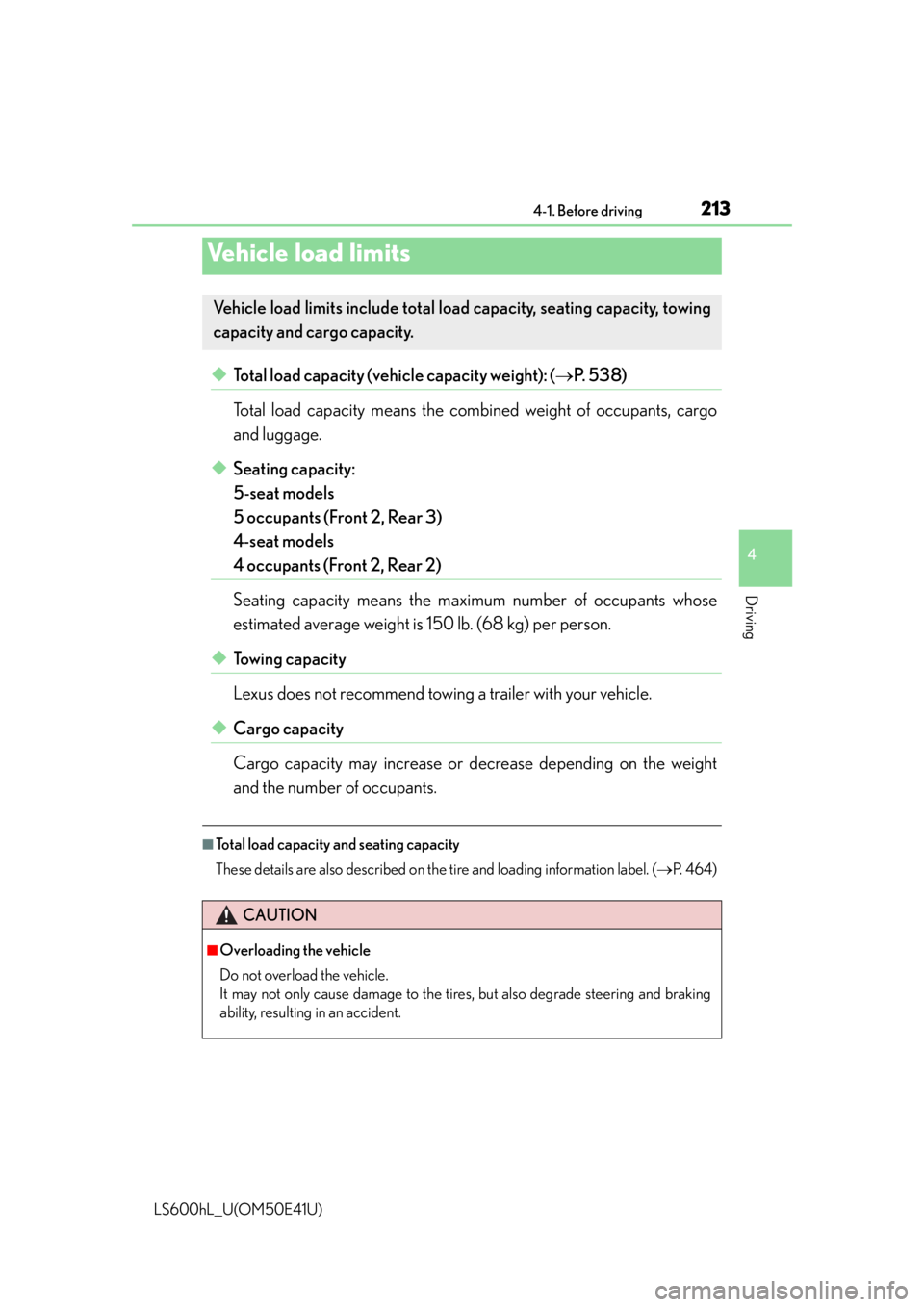Page 212 of 620
2104-1. Before driving
LS600hL_U(OM50E41U)
Cargo capacity
Total load capacity (vehicle
capacity weight) (P. 5 3 8 )
5-seat models
When 2 people with the combined weight of A lb. (kg) are riding in your
vehicle, which has a total load capacit y (vehicle capacity weight) of B lb.
(kg), the available amount of cargo and luggage load capacity will be C lb.
(kg) as follows:
B
*2 lb. (kg) - A*1 lb. (kg) = C*3 lb. (kg)
*1: A =Weight of people
*2: B =Total load capacity
*3: C =Available cargo and luggage load
In this condition, if 3 more passengers with the combined weight of D lb. (kg) get
on, the available cargo and luggage load will be reduced E lb. (kg) as follows:
C lb. (kg) - D*4 lb. (kg) = E*5 lb. (kg)
*4: D =Additional weight of people
*5: E =Available cargo and luggage load
Calculation formula for your vehicle
1
2
Page 213 of 620

2114-1. Before driving
4
Driving
LS600hL_U(OM50E41U)
4-seat models
When 2 people with the combined weight of A lb. (kg) are riding in your
vehicle, which has a total load capacit y (vehicle capacity weight) of B lb.
(kg), the available amount of cargo and luggage load capacity will be C lb.
(kg) as follows:
B
*2 lb. (kg) - A*1 lb. (kg) = C*3 lb. (kg)
*1: A =Weight of people
*2: B =Total load capacity
*3: C =Available cargo and luggage load
In this condition, if 2 more passengers with the combined weight of D lb. (kg) get
on, the available cargo and luggage load will be reduced E lb. (kg) as follows:
C lb. (kg) - D*4 lb. (kg) = E*5 lb. (kg)
*4: D =Additional weight of people
*5: E =Available cargo and luggage load
As shown in the example above, if the number of occupants increases, the
cargo and luggage load will be redu ced by an amount that equals the
increased weight due to the addition al occupants. In other words, if an
increase in the number of occupants causes an excess of the total load
capacity (combined weight of occu pants plus cargo and luggage load),
you must reduce the cargo and luggage on your vehicle.
Page 214 of 620

2124-1. Before driving
LS600hL_U(OM50E41U)
CAUTION
■Things that must not be carried in the trunk
The following things may cause a fire if loaded in the trunk:
●Receptacles containing gasoline
●Aerosol cans
■Storage precautions
Observe the following precautions.
Failure to do so may prevent the pedals from being depressed properly, may block
the driver’s vision, or may result in items hitting the driver or passengers, possibly
causing an accident.
●Stow cargo and luggage in the trunk whenever possible.
●Do not place cargo or luggage in or on the following locations.
• At the feet of the driver
• On the front passenger or rear seats (when stacking items)
• On the package tray
• On the instrument panel
•On the dashboard
• In front of the Remote Touch screen
●Secure all items in the occupant compartment.
■Capacity and distribution
●Do not exceed the maximum axle weight rating or the total vehicle weight rating.
●Even if the total load of occupant’s weight and the cargo load is less than the total
load capacity, do not apply the load unevenly. Improper loading may cause dete-
rioration of steering or braking control which may cause death or serious injury.
Page 215 of 620

2134-1. Before driving
4
Driving
LS600hL_U(OM50E41U)
◆Total load capacity (vehicle capacity weight): (P. 5 3 8 )
Total load capacity me ans the combined weight of occupants, cargo
and luggage.
◆Seating capacity:
5-seat models
5 occupants (Front 2, Rear 3)
4-seat models
4 occupants (Front 2, Rear 2)
Seating capacity means the maximum number of occupants whose
estimated average weight is 150 lb. (68 kg) per person.
◆Towing capacity
Lexus does not recommend towing a trailer with your vehicle.
◆Cargo capacity
Cargo capacity may increase or decrease depending on the weight
and the number of occupants.
■Total load capacity and seating capacity
These details are also described on the tire and loading information label. ( P. 4 6 4 )
Vehicle load limits
Vehicle load limits include total load capacity, seating capacity, towing
capacity and cargo capacity.
CAUTION
■Overloading the vehicle
Do not overload the vehicle.
It may not only cause damage to the tire s, but also degrade steering and braking
ability, resulting in an accident.
Page 289 of 620
2874-5. Using the driving support systems
4
Driving
LS600hL_U(OM50E41U)
The vehicle height is maintained at the selected level regardless of the
number of occupants and luggage weight.
Turns high mode on/off.
When on, the “HEIGHT HIGH” indi-
cator will come on.
■Operating sound of the ai r suspension compressor
When the vehicle height is lowered, such as when entering or loading the vehicle, or
high mode is selected, the compressor may operate and a whirring sound may be
heard. This does not indicate a malfunction.
Electronically modulated air suspension
By independently controlling the da mping force of the shock absorbers
for each of the 4 wheels according to the road and driving conditions
and the selected driving mode, this system achieves ride comfort with
superior steering stability, and ensures good vehicle posture.
In addition, vehicle height can be selected according to road and driv-
ing conditions.
Page 460 of 620

4586-3. Do-it-yourself maintenance
LS600hL_U(OM50E41U)
■Maximum load of tire
Check that the maximum load of the replacement tire is greater than 1 /2 of the
Gross Axle Weight Ratings (GAWR) of either the front axle or the rear axle, which-
ever is greater.
■Tire types
●Summer tires
Summer tires are high-speed performance tires best suited to highway driving
under dry conditions. Since summer tires do not have the same traction perfor-
mance as snow tires, summer tires are in adequate for driving on snow-covered or
icy roads. For driving on snow-covered road s or icy roads, the use of snow tires is
recommended. When installing snow tires, be sure to replace all four tires.
●All season tires
All season tires are designed to provide better traction in snow and to be ade-
quate for driving in most winter conditions as well as for use year-round. All season
tires, however, do not have adequate traction performance compared with snow
tires in heavy or loose snow. Also, all seas on tires fall short in acceleration and han-
dling performance compared with summer tires in highway driving.
●Snow tires
For driving on snow-covered roads or icy roads, we recommend using snow tires.
If you need snow tires, select tires of th e same size, construction and load capacity
as the originally installed tires. Since your vehicle has radial tires as original equip-
ment, make sure your snow tires also have radial construction. Do not install stud-
ded tires without first checking local regulations for possible restrictions. Snow
tires should be installed on all wheels. ( P. 325)
For the GAWR, see the Certification Label.
For the maximum load of the tire, see the load
limit at maximum cold tire inflation pressure
mentioned on the sidewall of the tire.
(
P. 5 5 3 )
Page 468 of 620

4666-3. Do-it-yourself maintenance
LS600hL_U(OM50E41U)
■Instructions for checking tire inflation pressure
When checking tire inflation pressure, observe the following:
●Check only when the tires are cold.
If your vehicle has been parked for at least 3 hours or has not been driven for more
than 1 mile or 1.5 km, you will get an accurate cold tire inflation pressure reading.
●Always use a tire pressure gauge.
It is difficult to judge if a tire is properly inflated based only on its appearance.
●It is normal for the tire inflation pressure to be higher after driving as heat is gener-
ated in the tire. Do not reduce tire inflation pressure after driving.
●Never exceed the vehicle capacity weight.
Passengers and luggage weight should be placed so that the vehicle is balanced.
CAUTION
■Proper inflation is critical to save tire performance
Keep your tires properly inflated.
If the tires are not properly inflated, the following conditions may occur which
could lead to an accident resulting in death or serious injury:
●Excessive wear
●Uneven wear
●Poor handling
●Possibility of blowouts resulting from overheated tires
●Air leaking from between tire and wheel
●Wheel deformation and/or tire damage
●Greater possibility of tire damage while driving (due to road hazards, expansion
joints, sharp edges in the road, etc.)
NOTICE
■When inspecting and adjusting tire inflation pressure
Be sure to put the tire valve caps back on.
If a valve cap is not installed, dirt or moisture may get into the valve and cause an air
leak, resulting in decreased tire inflation pressure.
Page 540 of 620
538
LS600hL_U(OM50E41U)
8-1. Specifications
*1: Unladen vehicles
*2: Vehicles with 18-inch tires
*3: Vehicles with 19-inch tires
*4:5-seat models
*5:4-seat models
Maintenance data (fuel, oil level, etc.)
Dimensions and weight
Overall length205.1 in. (5210 mm)
Overall width73.8 in. (1875 mm)
Overall height*158.3 in. (1480 mm)
Wheelbase121.7 in. (3090 mm)
Tr e a d
Front63.6 in. (1615 mm)*2
63.4 in. (1610 mm)*3
Rear63.6 in. (1615 mm)*2
63.4 in. (1610 mm)*3
Vehicle capacity weight
(Occupants + luggage)825 lb. (375 kg)*4
660 lb. (300 kg)*5